seats AUDI R8 SPYDER 2014 Owner's Manual
[x] Cancel search | Manufacturer: AUDI, Model Year: 2014, Model line: R8 SPYDER, Model: AUDI R8 SPYDER 2014Pages: 244, PDF Size: 61.06 MB
Page 118 of 244
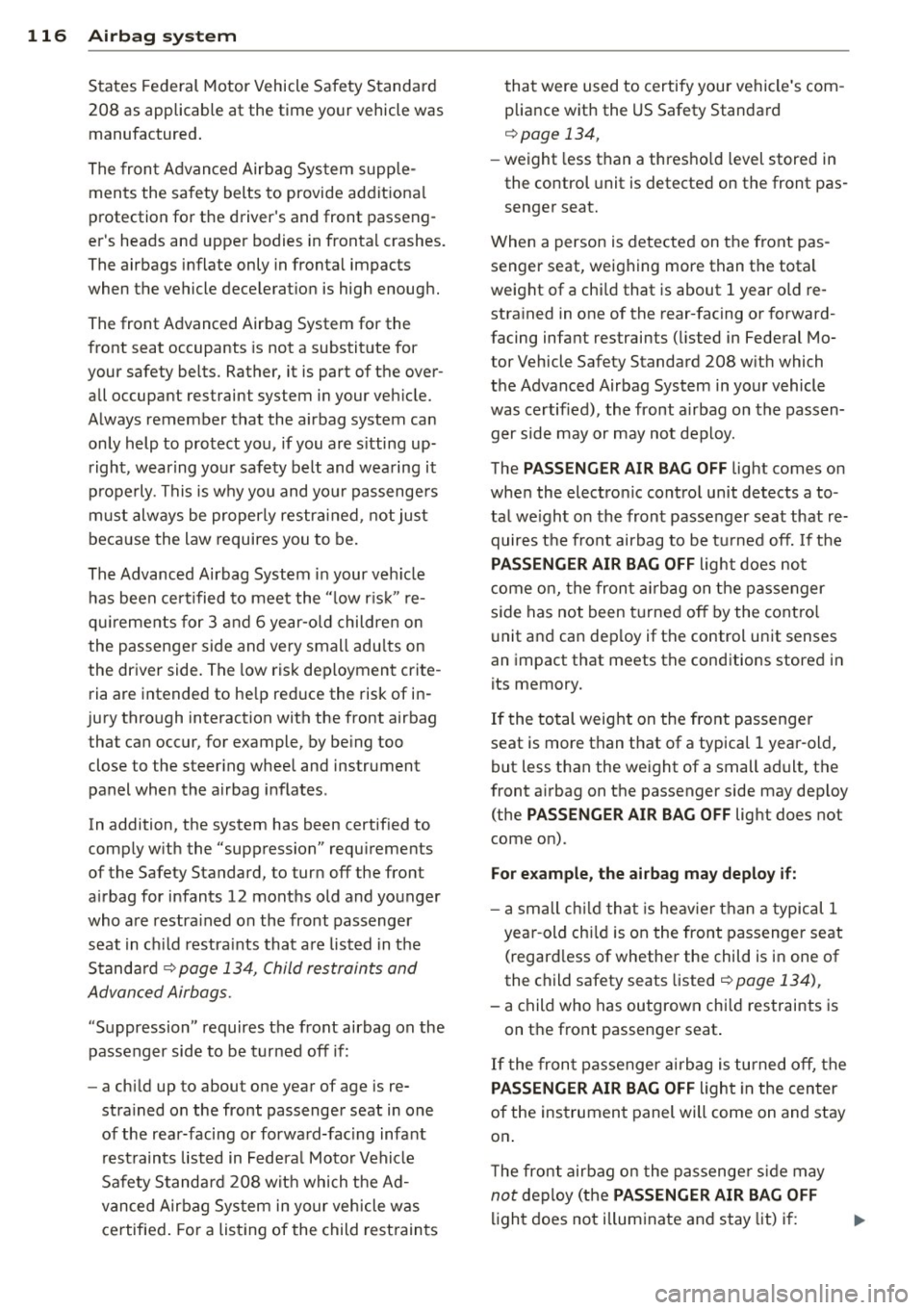
116 Airbag sys te m
States Federal Motor Vehicle Safety Standard
208 as applicable at the time your vehicle was manufactured .
The front Advanced Airbag Sys tem supp le
ments the safety belts to provide additional
protection for the driver's and front passeng
er 's heads and upper bodies in fronta l crashes.
The airbags inflate only in fronta l impacts
when the vehicle dece lerat ion is high enough.
The front Advanced Airbag System for the
front seat occupants is not a substitute for
your safety belts. Rather, it is part of the over all occupant restraint system in your veh icle.
A lways remember that the airbag system ca n
only help to protect you, if you are s itting up
right, wearing yo ur safety belt and wea ring it
p roperly. This is why you and you r passenge rs
must always be properly restr ained , not just
beca use the law requires you to be.
The Advanced Airbag System i n your veh icle
has been cer tified to meet the " low r is k " re
qu iremen ts for
3 an d 6 year-o ld childre n on
the passenger side and very small adu lts on
the driver side. The low risk deploymen t crite
ria are intended to he lp red uce the risk of in
jury through interaction with the front airbag that can occur, for example, by be ing too
close to the steer ing whee l and instrument
panel when the airbag i nflates .
In addition, the system has been certif ied to
comp ly w ith the "suppression" requ irements
of the Safety Standard, to tur n off the front
a irbag for infants
12 months old and younger
who a re restra ined on the front passenger
seat in c hild restra ints that a re listed in the
St anda rd ¢
page 134, Child restraints and
Advanced Airbags.
"Suppression" requires the front airbag on the passenger side to be turned off if :
- a ch ild up to about one year of age is re
stra ined on the front passenger seat in one
of the rear-facing or forwa rd-fac ing infa nt
rest raints listed in Federa l Motor Veh icle
Safety Standard 208 wit h whi ch the Ad
vanced Airbag System in your vehicle w as
certified . For a list ing of the child rest rain ts t
ha t were used to certify your vehicle 's com
pliance with the US Safety Standa rd
¢ page 134,
- weight less than a thres ho ld level stored in
the control unit is detected on the front pas
senger seat.
When a person is dete cted on the front pas
senger seat, weighing more than the tota l
weight of a chi ld that is about
1 year old re
stra ined in one of the rear-facing or forward
facing infant restraints ( listed in Federal Mo
tor Vehicle Safety Standard 208 w it h which
the Advanced Airbag System in your vehicle
was ce rtified), the front airbag on the passen
ger side may or may not deploy.
The
PASSENGER AIR BAG OFF light comes on
whe n the electro nic con trol unit detects a to
ta l we ight on the front passenger seat that re
quires t he front airbag to be tu rned off. If t he
PASSENGER AIR BAG OFF ligh t does no t
come o n, the fron t airbag on the passenger
s ide has not been turne d off by the cont ro l
u nit and can dep loy if the control unit senses
an impact that meets the conditions stored in
its memory.
If the total weight on the front passenge r
seat is more than that of a typica l
1 year-old,
but less than the we ight of a small ad ult, the
front a irbag on the passenger side may dep loy
(the
PASSENGER AIR BAG OFF light does not
come on).
For example , the airbag may deploy if:
- a small ch ild that is heav ier t han a typic al 1
yea r-old ch ild is on the front passenger seat
(regard less of whethe r the child is in one of
the child safety seats listed
¢ page 134),
-a child who has outgrown ch ild restraints is
on the front passenge r seat .
If the fron t passenger a irbag is turned off, the
PASSENGER AIR BAG OFF ligh t in the cen ter
of the ins trument panel will come on and stay
o n.
T he front airbag on the passenge r sid e may
not dep loy (the PASSENGER AIR BAG OFF
li ght does not illuminate a nd stay lit) i f:
Page 120 of 244

118 Airbag system
components is detected. The function of the
airbag indicator light is described in greater
detail below. Because the front passenger
seat contains important parts of the Ad
vanced Airbag System, you must take care to prevent it from being damaged . Damage to
the seat may prevent the Advanced Airbag for
the front passenger seat from doing its job in
a crash .
The front Advanced Airbag System
consists of the following:
-Crash sensors in the front of the vehicle that
measure vehicle acceleration/deceleration
to provide information to the Advanced Air bag System about the severity of the crash.
- An electronic control unit, with integrated
crash sensors for front and side impacts .
The control unit "decides " whether to fire
the front airbags based on the information received from the crash sensors. The control
unit also "decides" whether the safety belt
pre tensioners should be activated.
- An Advanced Ai rbag with gas generator for
the driver inside the steering wheel hub.
- An Advanced Airbag with gas generator in
side the inst rument panel for the front pas
senger.
- A weight-sensing mat under the upholstery
padding of the front passenger seat cushion
that measures the total weight on the seat.
The information registered is sent continu
ously to the electronic control unit to regu
late deployment of the front Advanced Air
bag on the passenger side.
- An airbag monitoring system and indicator
light in the instrument cluster
¢page 121.
- The PASSENGER AIR BAG OFF light comes
on and stays on in the center of the instru
ment panel ¢
page 122, fig. 120 and tells
you when the front Advanced Airbag on the passenger side has been turned off.
- A sensor below the safety belt latch for the
front seat passenger to measure the tension
on the safety belt. The tension on the safety
belt and the weight registered by the
weight-sensing mat help the control unit "decide" whether the front airbag for the front passenger seat should be turned off or
not
¢ page 112, Child restraints on the
front seat -some important things to
know.
- A sensor in the safety belt latch for the driv
er and for the front seat passenger that
senses whether that safety belt is latched or not and transmits this informa tion to the
electronic control unit .
.&_ WARNING
Damage to the front passenger seat can
prevent the front airbag from working
properly.
- Improper repair or disassembly of the
front passenger and driver seat will pre
vent the Advanced Airbag System from
functioning properly.
- Repairs to the front passenger seat must
be performed by qualified and properly
trained workshop personnel.
- Never remove the front passenger or
driver seat from the vehicle.
-Never remove the upholstery from the
front passenger seat.
- Never disassemble or remove parts from
the seat or disconnect wires from it.
- Never carry sharp objects in your pockets
or place them on the seat. If the weight
sensing mat in the passenger seat is
punctured it cannot work properly.
- Never carry things on your lap or carry
objects on the passenger seat. Such
items can increase the weight registered
by the weight-sensing mat and send the
wrong information to the airbag control
unit.
- Never store items under the front pas
senger seat. Parts of the Advanced Air
bag System under the passenger seat
could be damaged, preventing them and
the airbag system from working proper ly.
- Never place seat covers or replacement
upholstery that have not been specifical ly approved by Audi on the front seats .
- Seat covers can prevent the Advanced
-
Airbag System from recognizing child .,..
Page 121 of 244

restraints or occupants on the front pas
senger seat and prevent the side airbag
in the seat backrest from deploying prop
erly.
- Never use cushions, pillows, blankets or
similar items on the front passenger
seat. The add itional padd ing will prevent
the weight-sens ing mat in the seat from
accurately reg istering the ch ild restra int
or person on the seat and preve nt the
Advanced Airbag System from func tion
ing properly .
- If you must use a child restra int on the
front passenger seat and the ch ild re
straint manufacturer's instructions re
quire the use of a towel, foam cush ion or
something else to properly position the
child restraint, make certa in that the
PASSENGER AIR BAG OFF light comes
on and stays on whenever the child re
st ra int is installed on the front passen
ger seat .
- If the
PA SSE NGER AIR BAG OFF light
does not come on and stay on, have the
airbag system inspected by your Audi dealer.
How the Advanced Airbag System
components work together
The front Advanced Airbag System and the side airbags s upplement the protection of
fered by the front three-point safety be lts
with pretensioners and load limiters and the
adjustab le head restra ints to he lp reduce the
risk of injury in a wide range of acc ident and
crash situat ions . Be sure to read the impor
tant information about safety and heed the
WARNINGS in this chapter .
Deployment of the Advanced Airbag System
and the act ivat ion of the safety be lt preten
sioners depend on the dece le rat ion measured
by the c rash sensors and registered by the
e lectronic control un it . Crash severity depends
on speed and dece leration as well as the mass
and stiffness of the vehicle or object involved in the crash .
Airbag system 119
When the electronic control unit registers a
low severity cras h and the safety belt is being
used, the airbag will not dep loy. If the safety
belt is not being used, the first stage deploys,
followed by the second stage after a much lat er t ime in the crash sequence.
If the electron ic control unit registers a crash
of medium severity, the first stage of the air bag deploys followed by the second stage at a
much later time in the crash sequence -re
gardless of whether the safety belt is be ing
used or not . In higher sever ity crashes as reg
iste red by the elect roni c cont rol unit, bot h the
first and se cond s tages deploy almost at the
same t ime.
On the passenger side, regardless of safety
belt use, the airbag w ill be tu rned off if the
weight on the passenger sea t is less than the
amount programmed in the electronic control
u nit . The front airbag on the passenger side
will a lso be turned off if one of the child safe
ty seats that has been certified under Federal
Motor Vehicle Safety Standard 208 has been
recognized on the seat. The
PASS ENGER A IR
BAG OFF light comes on and stays on to tell
you when the front Adva nced A irbag on the
passenger side has been turned off
¢ page 112, Child restraints on the front seat
- some important things to know .
_&. WARNING ~
To reduce the risk of inj ury when an a irbag
inflates, always wear safety be lts properly.
- If you are unrestrained, leaning forward,
sitting sideways or o ut o f position in any
way, your risk of injury is m uch higher.
- You will a lso receive serious injuries and
could even be killed if yo u are up against
the airbag or too close to it when it in
f lates -even with an Advanced A irbag
¢page 111.
•
•
Page 122 of 244
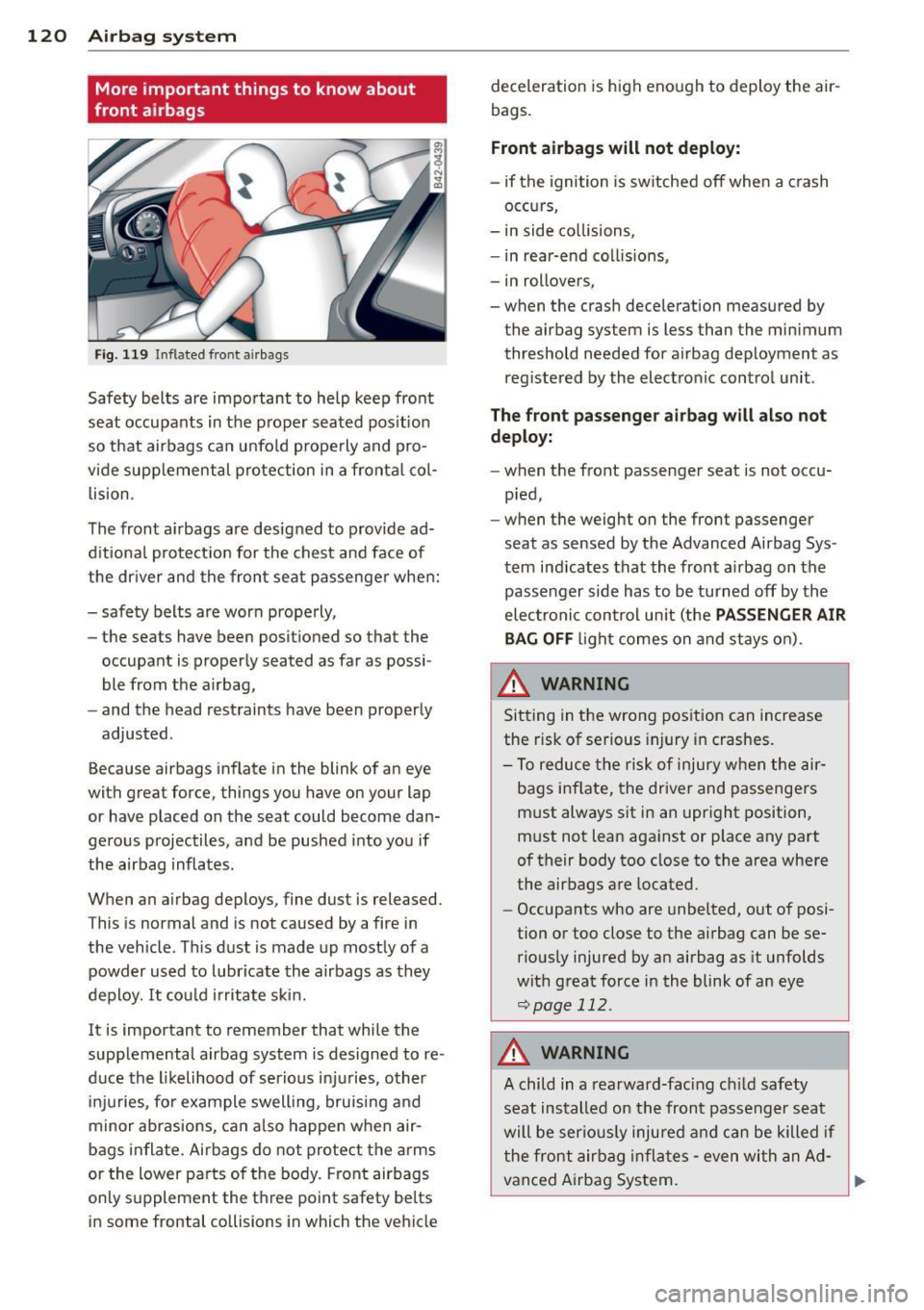
120 Airbag system
More important things to know about
front airbags
F ig. 1 19 Inflated fro nt airbags
Safety belts are impo rtant to help keep fro nt
seat occupants in the p roper seated pos it io n
so that airbags can unfo ld prope rly and pro
vide supplemental protection in a fronta l co l
lision .
The front a irbags are designed to provide ad
d itiona l protect ion for the chest a nd face of
the dr iver and the front seat passenger when:
- safety belts are worn properly,
- the seats have been positioned so that the
occupant is properly seated as far as possi
ble from the a irbag,
- and the head restraints have been properly
adjusted .
Because airbags inflate in the blink of an eye
with great force, things you have on your lap or have placed on the seat could become dan
gerous projectiles, and be pushed into you if
the airbag inflates .
When an a irbag deploys, fine dust is released.
This is normal and is not caused by a fire in
the vehicle . This dust is made up mostly of a
powder used to lubricate the airbags as they
deploy. It cou ld irritate ski n.
It is important to remember that while the
supp lemental airbag system is designed to re
duce the l ikelihood of serious inj uries, other
i n juries, fo r example swelling, bruisi ng and
m inor abrasions, ca n also happe n when air
bags in flate. Airbags do not protect the a rms
or the lower pa rts of the body. Front airbags
only supplement the t hree point safety belts
in some frontal collisions in which the vehicle deceleration
is high eno ugh to deploy the air
bags .
Front airbags will not deploy:
- if the ignition is sw itched off when a c rash
occu rs,
- in side co llisions,
- in rear-end co llisions,
- in rollovers,
-when the crash deceleration measured by the airbag system is less than the min imum
threshold needed for a irbag deployment as
reg istered by the electronic control unit .
The front pass enge r airbag will al so not
deploy:
- when the front passenger seat is not occu
p ied,
- when the weight on the front passenger
seat as sensed by the Advanced Airbag Sys
tem indicates that the front ai rbag on the
passenger side has to be turned off by the
elec troni c control un it (the
PASSENGER AIR
BAG OFF
li ght comes on and stays o n).
_&. WARNING ~
Si tting in the wrong position can increase
the r isk o f se rious injury i n crashes.
- To reduce the risk of inju ry w he n t he air
bags inflate, the drive r and passengers
m ust always sit in an upr ight position,
m ust not lean aga inst or place any part
of their b ody too close to the area where
the airbags a re located .
- Occupants who are unbelted, out of posi
tion or too close to the a irbag can be se
rio usly injured by a n airbag as it unfolds
wit h great force in the blink of an eye
<=:>page 112 .
_&. WARNING ~ -
A child in a rearward-fac ing c hild safety
seat installed on the front passenger seat
will be serio usly injured a nd ca n be killed if
the front air bag in fla tes -even with an Ad
vanced A irbag Sys tem.
Page 126 of 244
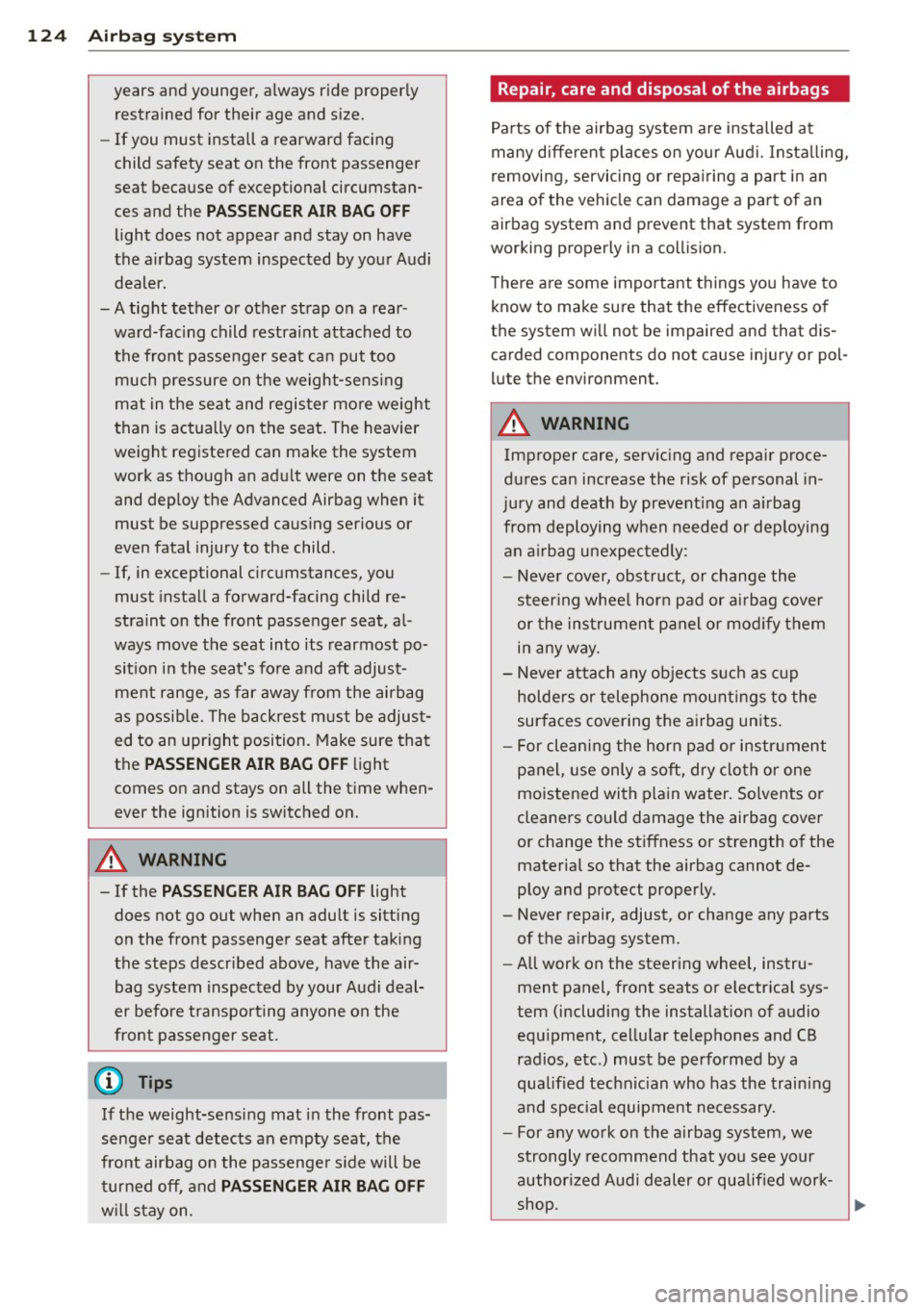
124 Airbag sys te m
years and younger, a lways ride proper ly
restrained for their age and s ize.
- If you must install a rearward facing
child safety seat on the front passenger
seat because of exceptional circumstan
ces and the
P ASS ENGER AIR BAG OFF
light does not appear and stay on have
the a irbag system inspected by your Audi
dealer.
-A tight tether or other strap on a rear ward-fac ing child restra int attached to
the front passenger seat can put too much pressure on the weight-sens ing
mat in the seat and register mo re weight
than is actually on the seat. The heavier
weight registered can make the system
work as though an ad ult were on the seat
and dep loy the Advanced Airbag when it
must be suppressed caus ing serious or
even fatal injury to the child.
- If, in exceptional circumstances, you
must install a forward-facing child re
straint on the front passenger seat, a l
ways move the seat into its rearmost po
sit ion in the seat's fo re and aft adjust
ment range, as far away from the airbag
as possib le. The backrest m ust be adjus t
ed to an upr ight position. Make sure that
the
PASSENGER AIR BAG OFF light
comes on and stays on all the t ime when
ever the ignition is switched on.
A WARNING
- If the PASSENGER AIR BAG OFF light
does not go out when an adult is sitting
on the front passenge r seat afte r taking
the steps described above, have the air bag system inspected by your Audi deal
er before transpor ting anyone on the
front passenger se at.
(D Tips
If the weight-sensing mat in the front pas
senger seat detects an empty seat, the
front airbag on the passenge r side will be
turned off, and
PASSENGER AIR BAG OFF
w ill stay on.
-
Repair, care and disposal of the airbags
Pa rts of the airbag system are i nstalled at
many diffe rent p laces o n your Aud i. Insta llin g,
removi ng, servicing or repa iring a part in an
area of the veh icle can damage a part of an
airbag system and prevent that system from
working properly in a coll is ion.
T he re a re some important t hings yo u have to
know to make sure that the effectiveness o f
t h e system wi ll not be impaired and that dis
carded components do not cause injury or pol
l ute the environment.
A WARNING
Improper care, serv ic ing and repair proce
du res can increase the risk of personal in
j u ry and death by prevent ing an a irbag
from deploying when needed or dep loying
an a irbag une xpec tedly:
- Never cover, obst ruct, or change the
steer ing whee l horn pad or ai rbag cover
or the in st rument panel or mod ify them
in any way .
- Never attach any objects s uch as c up
holders or telephone mountings to the
sur faces covering the a irbag un its.
- For cle aning the horn pad or instr ument
panel, use only a soft, dry clo th or one
moistened with pla in water. Solvents o r
cleaners could damage the airbag cover
or change the st iffness or strength of the
material so that the airbag cannot de
p loy and protect properly.
- Never repair, adjust, or change any parts
of the a irbag system.
- All work on the steering wheel, instru
ment panel, front seats or e lectr ica l sys
tem (including the installation of audio
equ ipment, cellu lar telep hones and CB
radios, etc.) must be performed by a
qualified technic ian who has the training
and specia l equipment ne cessary.
- For any wo rk on the airbag system, we
strongly recommend that you see your
author ized Audi dealer or qualified work-
shop. ..,.
Page 134 of 244
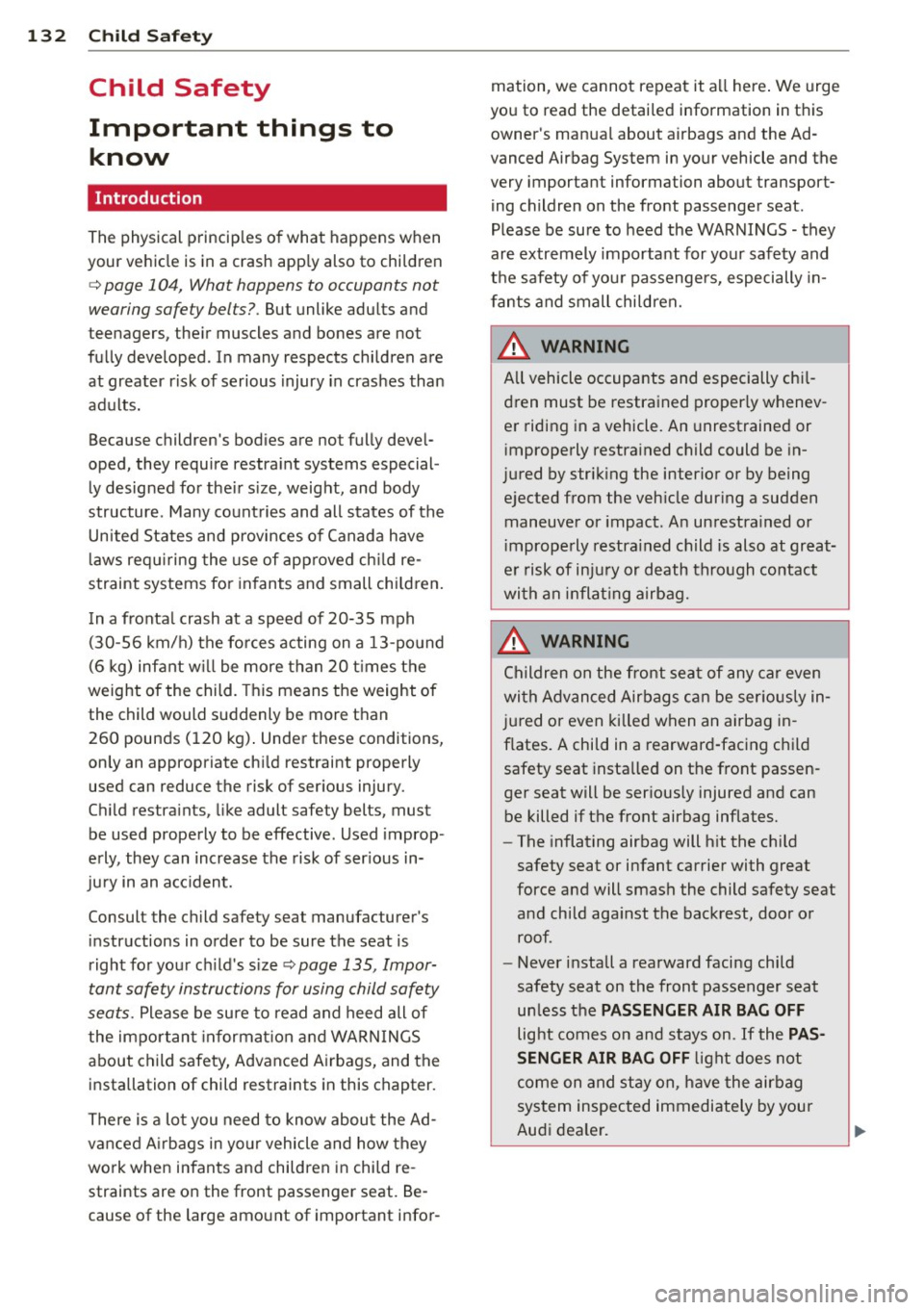
132 Child Safety
Child Safety
Important things to know
Introduction
The physical principles of what happens when
your vehicle is in a crash apply also to children
c::> page 104, What happens to occupants not
wearing safety belts? .
But unlike adults and
teenagers, their muscles and bones are not
fully developed . In many respects children are
at greater risk of serious injury in crashes than
adults.
Because children's bodies are not fully devel
oped, they require restraint systems especial
ly designed for their size, weight, and body
structure . Many countries and all states of the
United States and provinces of Canada have
laws requiring the use of approved child re
straint systems for infants and small children.
In a frontal crash at a speed of 20-35 mph
(30-56 km/h) the forces acting on a 13-pound
(6 kg) infant will be more than 20 times the
weight of the child. This means the weight of
the child would suddenly be more than 260 pounds (120 kg). Under these conditions,
only an appropriate child restraint properly used can reduce the risk of serious injury.
Child restraints, like adult safety belts, must
be used properly to be effective. Used improp
erly, they can increase the risk of serious in
jury in an accident.
Consult the child safety seat manufacturer's instructions in order to be sure the seat is
right for your child's size
c::> page 135, Impor
tant safety instructions for using child safety
seats.
Please be sure to read and heed all of
the important information and WARNINGS
about child safety, Advanced Airbags, and the
installation of child restraints in this chapter.
There is a lot you need to know about the Ad
vanced Airbags in your vehicle and how they
work when infants and children in child re
straints are on the front passenger seat. Be
cause of the large amount of important infor- mation, we cannot repeat it all here. We urge
you to read the detailed information in this
owner's manual about airbags and the Ad
vanced Airbag System in your vehicle and the
very important information about transport ing children on the front passenger seat.
Please be sure to heed the WARNINGS - they
are extremely important for your safety and
the safety of your passengers, especially in
fants and small children.
A WARNING
-
All vehicle occupants and especially chil
dren must be restrained properly whenev
er riding in a vehicle. An unrestrained or
improperly restrained child could be in
jured by striking the interior or by being
ejected from the vehicle during a sudden maneuver or impact. An unrestrained or
improperly restrained child is also at great
er risk of injury or death through contact
with an inflating airbag.
_& WARNING
Children on the front seat of any car even
with Advanced Airbags can be seriously in
jured or even killed when an airbag in
flates. A child in a rearward-facing child
safety seat installed on the front passen
ger seat will be seriously injured and can
be killed if the front airbag inflates.
- The inflating airbag will hit the child
safety seat or infant carrier with great
force and will smash the child safety seat
and child against the backrest, door or roof.
- Never install a rearward facing child
safety seat on the front passenger seat
unless the
PASSENGER AIR BAG OFF
light comes on and stays on. If the PAS·
SENGER AIR BAG OFF
light does not
come on and stay on, have the airbag
system inspected immediately by your
Audi dealer.
.
Page 137 of 244
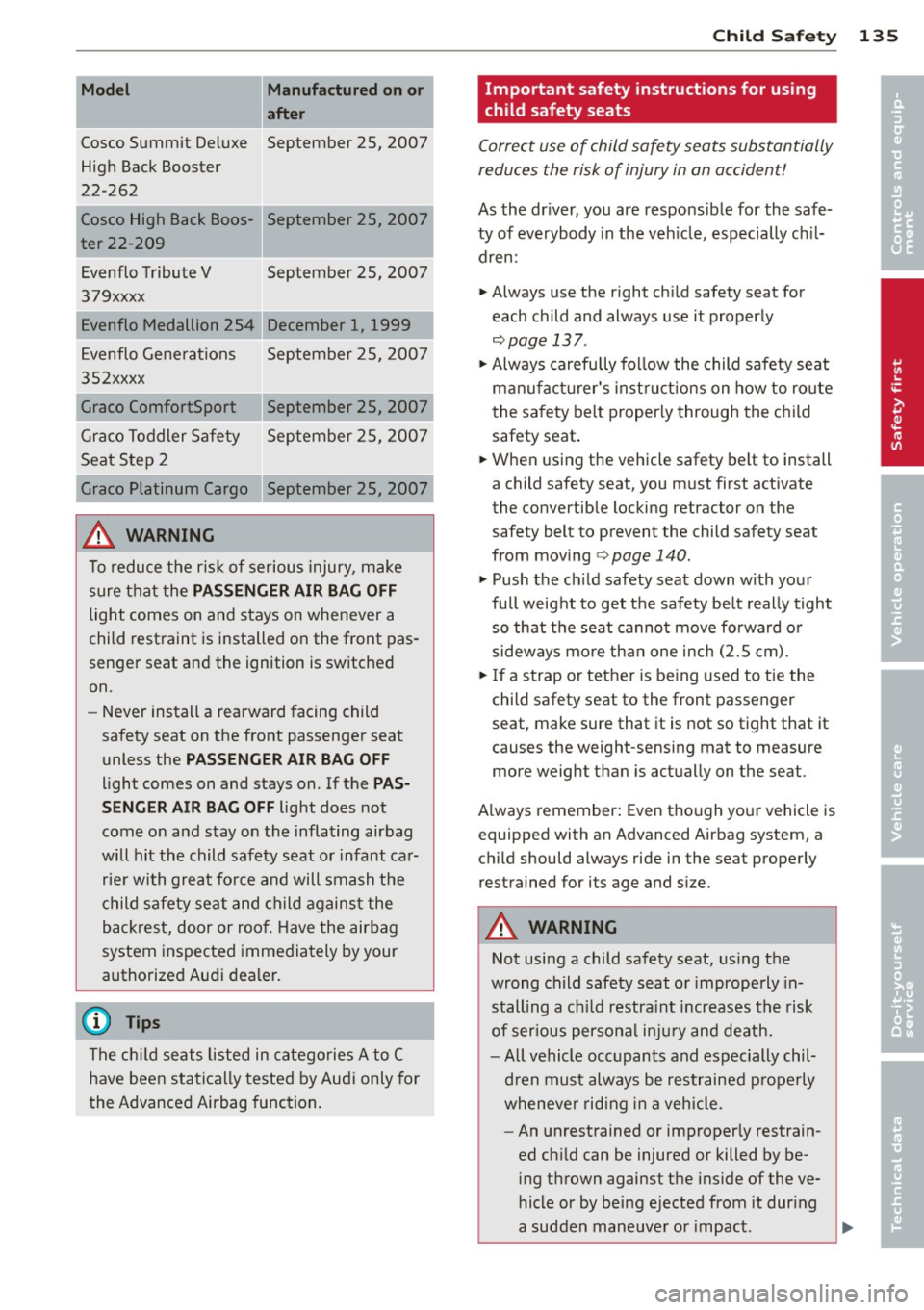
Model Manufactured on or
after
Cosco Summit Deluxe September 25, 2007
H igh Back Bo oste r
22-262
Co sco High Bac k Boos -September 2S, 2007
ter 22- 209
Evenfl o Tribut e V
379xxxx September 25, 2007
December 1, 1999
E
venflo Genera tions September 25, 2007
35 2xxxx
Grace ComfortSport September 2S, 2007
Grace Toddler Sa fety September 25, 200 7
Seat Step 2
Graco Platinum Cargo September 25, 2007
A WARNING
T o reduce the risk of serious injury, make
sure that the
PASSENGER AIR BAG OFF
light comes on and stays on whenever a
child rest raint is installed on the front pas
senger seat and the ignition is switched
on.
- Never install a rearward facing child
safety seat on the front passenger seat
unless the
PASSENGER AIR BAG OFF
light comes on and stays on. If the PAS
SENGER AIR BAG OFF
light does not
come on a nd stay on the inflating airbag
will hit the child safety seat o r infant ca r
rie r wi th great fo rce and will smash the
c hild s afety seat and child agains t the
backrest, door or roof . Have the airbag
system inspected immedia tely by your
authorized Audi dealer.
(D Tips
The ch ild seats listed in catego ries A to C
have been sta tica lly tested by Au di only for
the Advanced Airbag function.
.
Child Sa fet y 135
Important safety instructions for us ing
child safety seats
Correct use of child safety seats substantially
reduces the risk of injury in an accident!
As the dr iver, you are respons ible for the safe
ty of everybody in the veh icle , especially ch il
dren:
.. Always use the right ch ild safety seat for
each child and always use it properly
r=;, page 137.
.. Always carefully fo llow the child safe ty seat
manufac turer's inst ruct io ns on how to ro ute
the sa fe ty be lt properly through the c hild
safety seat .
.. When using the vehicle safety belt to install
a child safety seat, you m ust first activate
the convertible locking retractor on the
safety belt to prevent the child safety seat
from mov ing
¢ page 140 .
.. Push the ch ild safety seat down with yo ur
full weight to get the safety be lt really tight
so that the seat cannot
move fo rwa rd o r
sideways more th an one inch
(2.5 cm).
.. If a s trap or tet her is be ing used to tie the
child safety seat to the front passenger
seat, make sure that it is not so tight that it
causes the weight-sensing mat to measure
more weight than is act ually on the seat.
A lways remember : Even tho ugh yo ur vehicle is
equipped with an Advanced Airbag system, a
c hi ld should always ride in the seat properly
restrained for its age and s ize.
A WARNING
N ot using a child safety seat, using the
wrong ch ild safety seat o r imprope rly in
stalling a ch ild restraint increases the risk
of ser ious persona l inju ry and death.
- All vehicle occupants and especially chil
dren must always be restrained p rope rly
wheneve r riding in a vehicle.
-
- An unrest rained or improper ly restrain
ed ch ild can be injured or killed by be
i ng t hrown against the ins ide of the
ve
hicle or by being e jected from it dur ing
a sudden maneuve r o r i mpact .
•
•
Page 138 of 244
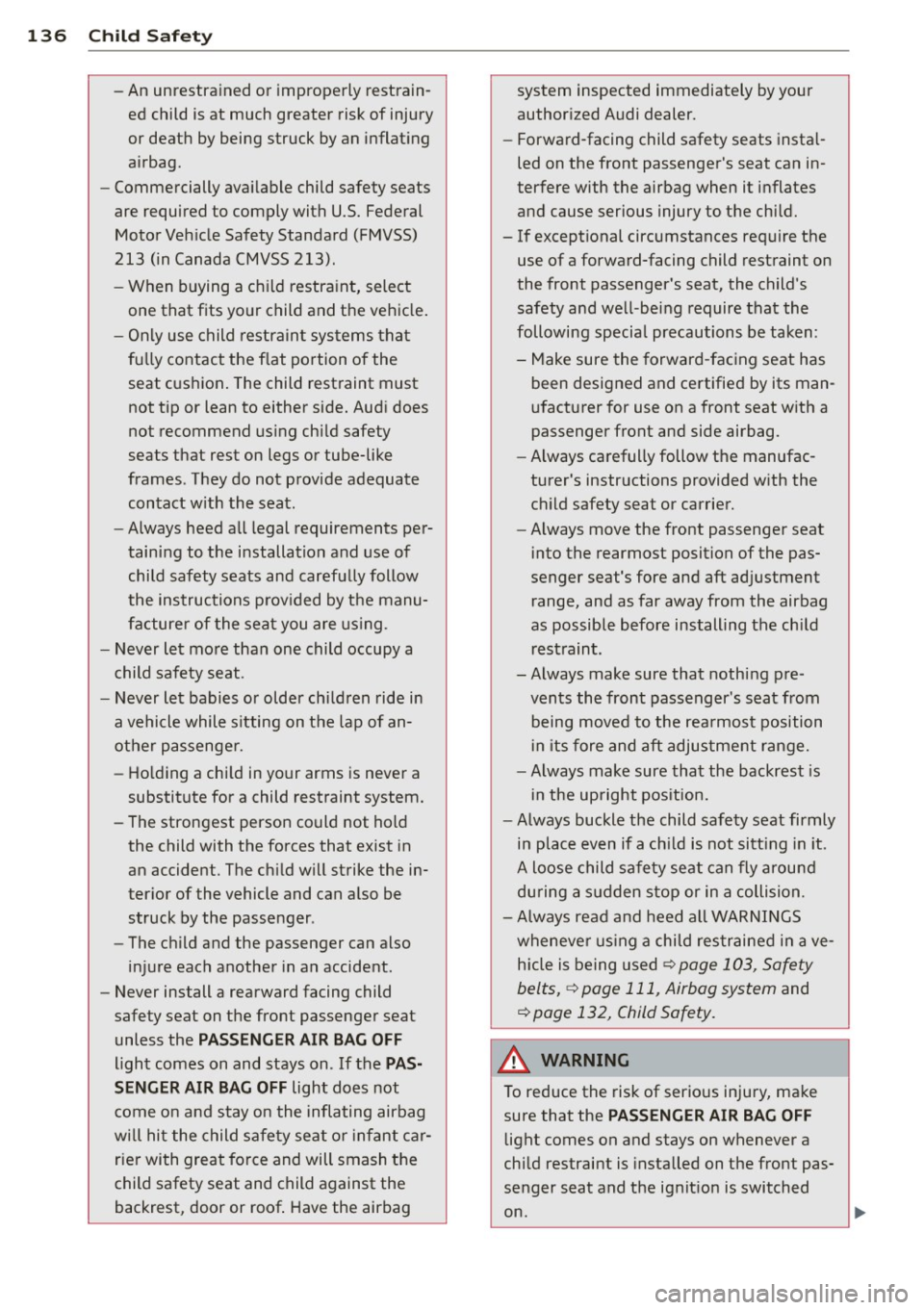
136 Child Safety
-An unrestrained or improperly restrain
ed child is at much greater risk of injury
or death by being struck by an inflating
airbag .
- Commercially available child safety seats
are required to comply with U.S. Federal
Motor Vehicle Safety Standard (FMVSS)
213 (in Canada CMVSS 213).
- When buying a child restraint, select
one that fits your child and the vehicle.
- Only use child restraint systems that
fully contact the flat portion of the
seat cushion. The child restraint must
not tip or lean to either side. Audi does
not recommend using child safety
seats that rest on legs or tube-like
frames . They do not provide adequate
contact with the seat .
- Always heed all legal requirements per
taining to the installation and use of
child safety seats and carefully follow
the instructions provided by the manu
facturer of the seat you are using.
- Never let more than one child occupy a
child safety seat.
- Never let babies or older children ride in
a vehicle while sitting on the lap of an
other passenger.
- Holding a child in your arms is never a
substitute for a child restraint system.
- The strongest person could not hold
the child with the forces that exist in
an accident. The child will strike the in
terior of the vehicle and can also be
struck by the passenger .
- The child and the passenger can also
injure each another in an accident.
- Never install a rearward facing child
safety seat on the front passenger seat
unless the
PASSENGER AIR BAG OFF
light comes on and stays on. If the PAS
SENGER AIR BAG OFF
light does not
come on and stay on the inflating airbag
will hit the child safety seat or infant car
rier with great force and will smash the
child safety seat and child against the
backrest, door or roof. Have the airbag system inspected immediately by your
authorized Audi dealer.
- Forward-facing child safety seats instal
led on the front passenger's seat can in
terfere with the airbag when it inflates
and cause serious injury to the child.
- If exceptional circumstances require the
use of a forward-facing child restraint on
the front passenger's seat, the child's
safety and well -being require that the
following special precautions be taken :
- Make sure the forward-facing seat has
been designed and certified by its man
ufacturer for use on a front seat with a
passenger front and side airbag.
- Always carefully follow the manufac
turer's instructions provided with the
child safety seat or carrier.
- Always move the front passenger seat
into the rearmost position of the pas
senger seat 's fore and aft adjustment
range, and as far away from the airbag
as possible before installing the child
restraint.
- Always make sure that nothing pre
vents the front passenger's seat from
being moved to the rearmost position
in its fore and aft adjustment range.
- Always make sure that the backrest is
in the upright position.
- Always buckle the child safety seat firmly
in place even if a child is not sitting in it.
A loose child safety seat can fly around
during a sudden stop or in a collision.
- Always read and heed all WARNINGS
whenever using a child restrained in ave
hicle is being used
¢ page 103, Safety
belts,
¢ page 111, Airbag system and
~ page 132, Child Safety .
A WARNING ~
To reduce the risk of serious injury, make
sure that the
PASSENGER AIR BAG OFF
light comes on and stays on whenever a
child restraint is installed on the front pas
senger seat and the ignition is switched
on.
Page 139 of 244
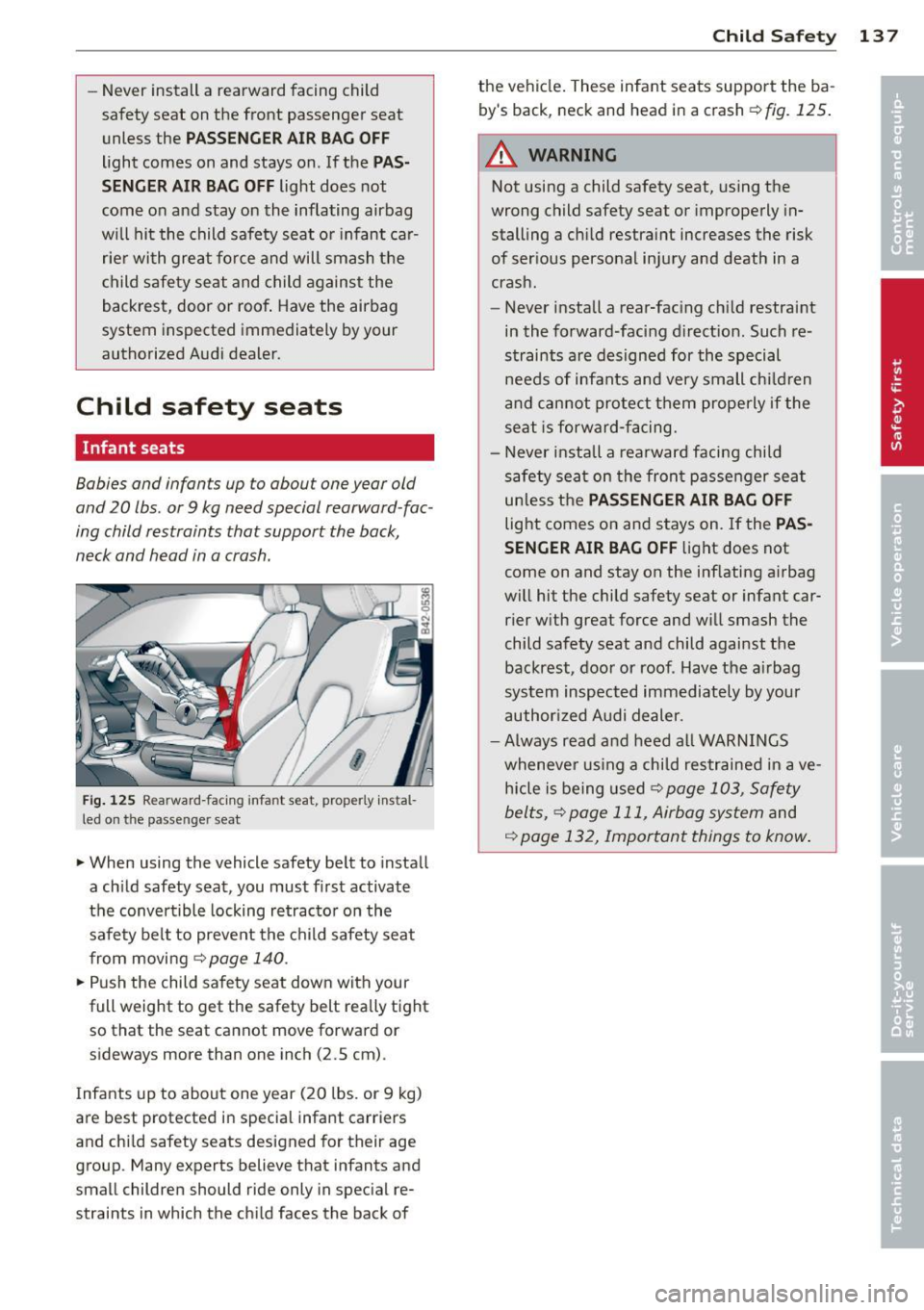
-Never install a rearward facing child
safety seat on the front passenger seat
unless the
PAS SENGER AIR BA G OFF
light comes on and stays on . If the PA S
SEN GER AI R BAG OFF
light does not
come on and stay on the inflating airbag
will hit the child safety seat o r infant car
r ie r with great fo rce and will smash the
child safety seat and child against the
backrest, door or roof . Have the airbag
system inspected immediately by your authorized Audi dealer .
Child safety seats
Infant seats
Babies and infants up to abou t one year old
and 20 lbs . or 9 kg need special rearward -fac
ing child restraints that support the back,
neck and head in a crash.
Fig . 125 Re arwar d-fa cing infan t sea t, pr operly instal
le d on t he p asseng er se at
"' When using the vehicle safety belt to in stall
a ch ild safety seat , you must first activate
the convertible locking retractor on the
safety belt to prevent the ch ild safety seat
from moving
r::!v page 140 .
"' Push the child sa fety seat dow n with your
full weight to get the safety bel t rea lly tight
so that the seat cannot move forward or
sideways more than one inch (2 .5 cm) .
I nfants up to about one year (20 lbs. or 9 kg)
are best prot ected in special infant carriers
and chi ld safety seats design ed for their age
group . Many experts believe that infants and
sm all ch ildren should ride only in spec ia l re
straints in which the ch ild faces the back of
Child S afety 13 7
the vehicle. These infant seats support the ba
by 's back, neck and head in a crash~
fig. 125.
A WARNING
Not using a child safety seat, using the
wrong child safety seat or improperly in
stalling a child restraint increases the risk
of ser ious personal injury and death in a
crash.
- Never install a rear-fac ing ch ild restraint
in the forward -facing d irect ion . Such re
straints are designed for the special needs of infants and very small chi ld ren
and cannot protect them properly if the
seat is forward-facing.
- Never install a rearward facing child
safety sea t on the fron t passenger seat
un less t he
PASSENGER AIR BAG OFF
light comes on and stays on. If the PAS·
SENGER A IR BAG OFF
light does not
come on and stay on the inf lating a irbag
will hit the child safety seat or infant car
rier w ith great f orce and w ill smash the
child safety seat and child against the backrest, door or roof . Have the a irbag
sys tem inspected immediately by your
author ized Audi dealer.
- Always read and heed al l WARNINGS
whenever us ing a child restrained in ave
hicle is being used
r::!v page 103, Safety
belts, r::!vpage 111, Airbag system
and
r::!v page 132, Important things to know .
Page 140 of 244
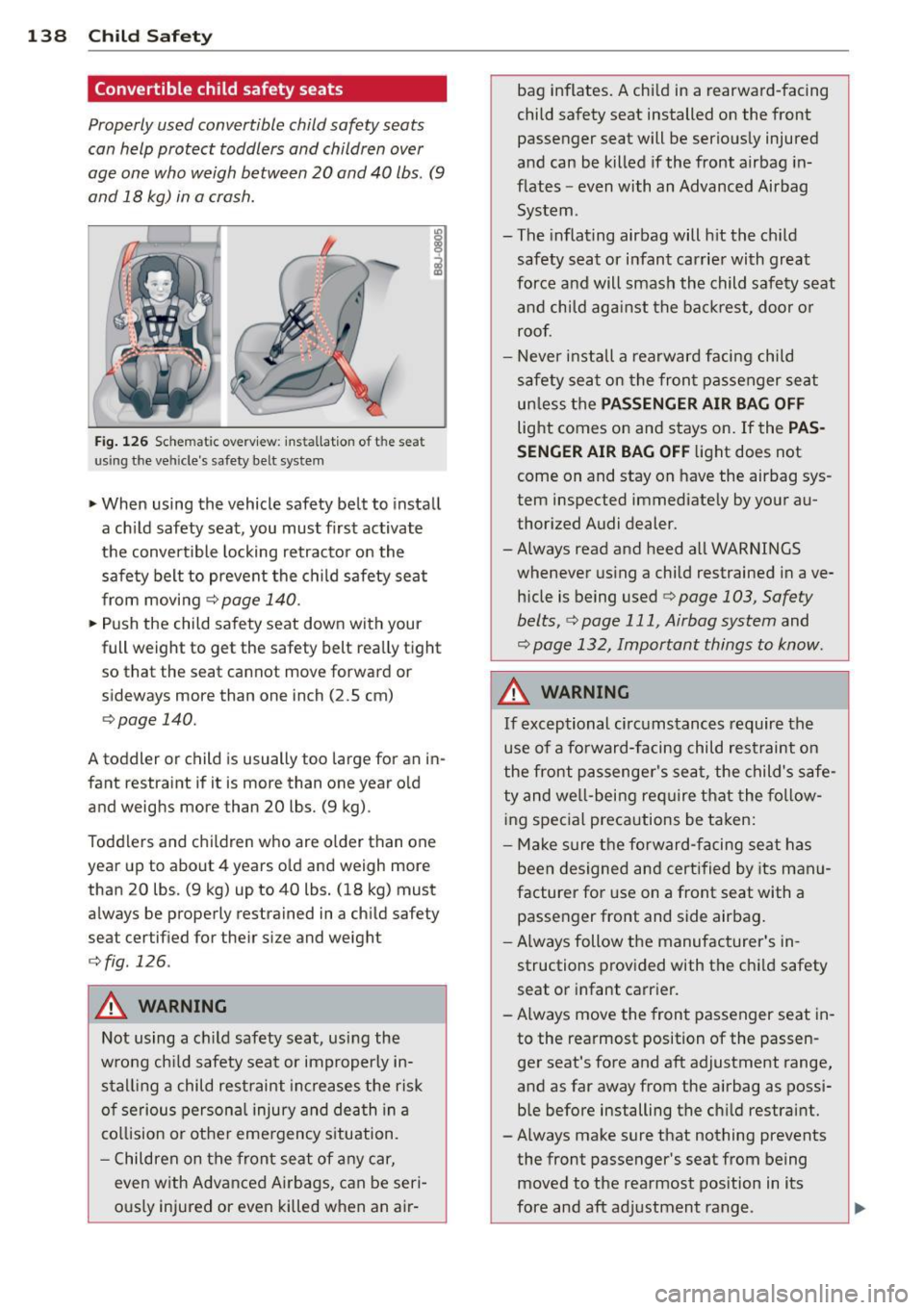
138 Child Safet y
Convertible child safety seats
Properly used convertible child safety seats
can help protect toddlers and children over
age one who weigh between
20 and 40 lbs. (9
and 18 kg) in a crash.
Fig . 126 Schematic overv iew: installat ion of the seat
usin g the vehicle's safety belt system
~ When using the vehicle safety belt to install
a ch ild safety seat, you must first activate
the convertible locking retractor on the safety belt to prevent the c hild safety seat
from movi ng
Q page 140.
~ Push the child safety seat down with your
full weight to get the safety belt rea lly tight
so that the seat cannot move forward or
sideways more than one inch (2.5 cm)
Qpage 140.
A toddler or child is usually too large for an in
fant restraint if it is more than one year old
and weighs more than 20 lbs. (9 kg) .
Toddlers and ch ildren who are o lder than one
year up to about 4 years o ld and weigh more
than 20 lbs . (9 kg) up to 40 lbs. (18 kg) must
always be properly restrained in a child safety
seat certi fied for the ir size and weight
Qfig. 126.
&_ WARNING
Not using a ch ild safety seat, us ing the
w rong ch ild safety seat or improperly in
stal ling a child restraint increases the risk
o f se rious persona l injury and death in a
co llision or othe r eme rgency s ituation.
- Children on t he front seat of a ny car,
even w ith Advanced A irbags, can be seri
ous ly injured or even killed when an air- bag inflates. A chi
ld in a rearward-facing
child safety seat installed on the front
passenger seat will be seriously injured
and can be killed if the front airbag in
flates -even with an Advanced Airbag
System .
- The inflating airbag will h it the ch ild
safety seat or infant carrie r with great
for ce and will smash the child safety seat
and child aga inst the ba ckrest, door or
roof .
- Neve r install a rearward facing child
safety sea t on the fron t passenger seat
un less the
PASSENGER AIR BAG OFF
light comes on and stays on. If the PAS
SENGER AIR BAG OF F
light does not
come on and stay on have the airbag sys
tem inspected immediately by your au
thorized Audi dealer.
- Always read and heed all WARNINGS
whenever us ing a child restrained in ave
h icle is being used
¢ page 103, Safety
belts,
Q page 111, Airbag system and
Q page 132, Important things to know .
&_ WARNING
--
If exceptional circumstances require the
use of a fo rward-facing child restraint on
the front passenger 's seat , the child's safe
ty and well-bei ng req uire t hat the fo llow
i ng spec ial precautions be taken:
- Make sure the forward- facing seat has
been designed and cert ified by its man u
facturer for use on a front seat with a
passenger front and side airbag.
- Always follow the manufacturer 's in
structions p rovided with the chi ld safety
seat or infant carrier.
- A lways move the front passenger seat in
to the rearmost position of the passen ger seat's fore and aft adjustment range,
and as far away from the airbag as possi
b le before installing the child restraint.
- Always make sure that nothing prevents
the front passenger 's seat from being
moved to the rearmost position in its
fore and aft adjustment range .